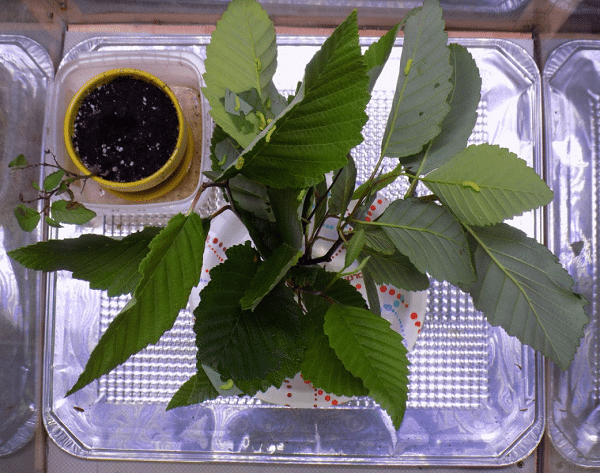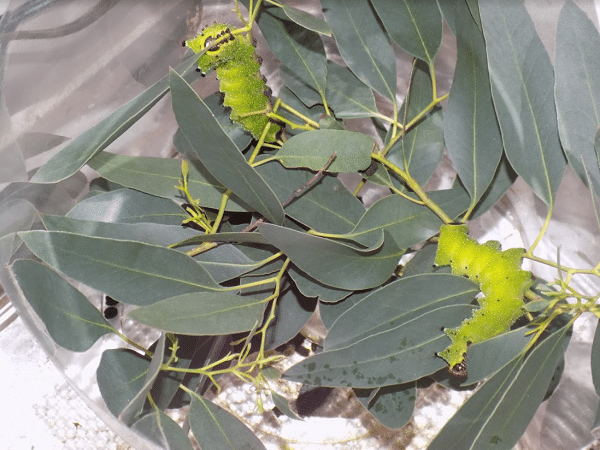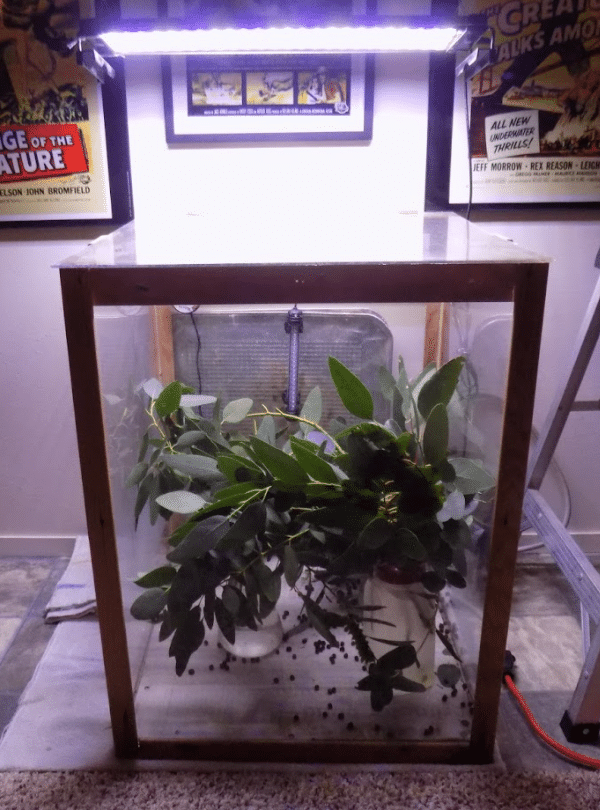Text and pictures by Kevin Koeffel, InsectNet member
These are my experiences and techniques, from some years of experience, others may have different experiences and techniques.
How to care butterfly eggs ?
Nearly all ova can be treated the same way, when I first have the eggs, either from a purchase, or laid by an adult insect, I put the ova in a small container, like a petri dish, sometimes I use a deli style container.If the lid fits tightly, like a deli container, I’ll punch some very small holes in the lid. It’s going to be important to be able to see into the container so you don’t miss hatching larva. Keep the container out of sunlight, room temperature is sufficient to hatch even tropical species. Misting ova is not needed, never put leaves in with unhatched ova, they can give off carbon dioxide and suffocate the eggs. Most, but not all eggs will hatch at more or less the same time, sometimes, two or three days can separate hatchings, Butterfly eggs, typically hatch quickly, in a week or less,Saturniidae ova take 10-14 days, on average, there are species which can take up to 30 days, your seller might be able to provide that information, it can rarely be found on the internet, it’s just not a subject that is searchable, Sphinx ova will hatch very quickly as well, usually less than a week.
How to feed the caterpillars ?
Once the larva starts hatching,the work begins. Some hatchlings will consume all or part of the egg shell, while they will often begin eating leaves right away, they can go a few days without food if you’re having trouble with finding a food plant they’ll accept. If they don’t seem to be eating, misting lightly will at least keep them from dehydrating,and I feel it may stimulate the larva to try a leaf. Often the food plants we have at hand are alternates, not the larva’s natural food in the wild. Sometimes cutting a leaf can stimulate a feeding response.
Larva will typically accept mature leaves, and don’t seem interested in fresh new growth, even though that new growth is more tender.

How to move caterpillars without hurting them ?
Moving larva, is difficult at times, their legs are tiny and fragile, but can be very tenacious in grabbing onto a surface, I use a small hobby paint brush, and sometimes wet the tip to get a larva to stick, and then transfer it onto a leaf, this can be very time consuming and frustrating. Using a hatching container with a smooth surface will help in preventing the hatchlings from latching onto something you can’t get them off of. Another method, once the larvae are hatching, is to put a leaf, or piece of paper into their hatching container and allow them to walk onto it, then you can move them around once they’re on that. Once the larva are hatched, having leaves in with them isn’t an issue, like it is with the unhatched eggs.
Typically, I use a largish plastic container until the hatchlings molt the first time, something with a bottom that you can see the frass, or droppings on, and smooth, so wandering larva can be replaced onto the food plant. I use a tall container with a lid, the larvae are small and you don’t want them wandering off,or through a wide screen cage.
How to keep caterpillar food plant fresh ?
I keep all my cut food plant in water, it’s very important to prevent the larva from drowning, with a paper towel, or sponge cut to size, any container that won’t tip over will work, I like Erlenmeyer flasks for this, cut food in water can last several days, but it is also important to keep an eye on the water level, as the cut branches suck up water. Sometimes I use a spray bottle to top off the water level,it’s non-invasive,as opposed to removing your material and refilling it under a faucet.

Lighting technique
During this time,before the first molt, I don’t give much concern to lighting, the larva should have a day night cycle, but at this time, ambient light is sufficient. Once the larva has molted for the first time, they’ll be easier to work with, they’ll be bigger, easier to see, and once they’re eating, that’s their focus, to eat. After this first molt, I usually will move the larva to a cage they can carry out their entire cycle in, you can buy a screen cage, make your own with window screen, or even plastic panels if you’re keeping larva that need a higher humidity or temperature. Lighting is something I address at this time, full spectrum lighting is great, and led lights are inexpensive, you can also use a timer to simulate any length of day and night you wish, equatorial species in nature experience 12 hours of day, and 12 of dark,although I will normally give them 14 to 15 hours of light, and larva will also eat after dark oftentimes. Northern hemisphere natives are normally active in the summer, and a corresponding day length should be used.

Giving caterpillars fresh leaves
Once the larvae are eating and settled in to doing that, they’ll grow quickly. Still, until a larva has molted several times, it’s going to still be too small to move by picking it up. When it’s time to give them fresh leaves, you can either place new branches in with the old,and the larva will move onto the new material, you can also move larva by cutting a branch or leaf and placing it onto the new foliage. Larva that are getting ready to molt will stop eating and park themselves somewhere for a day or two, moving a larva that’s getting ready to molt can be tricky, you want to be gentle with them and if you are moving their branch or leaf, make sure the larva is placed so it’s body isn’t in contact with anything else, it’s orientation isn’t critical, for instance, if you were to cut a branch with a caterpillar that isn’t moving, it can be placed pretty much any which way, as long as it’s not in contact with another branch.
How to handle big caterpillars ?
You’ll know when a larva is safe to pick up, it’ll be big, and when they are walking around you can move them to fresh leaves, this can still take patience and care, they don’t know you’re trying to help them, and can hang on tightly, to their foodplant, or, when you get them loose, your finger, for the most part, larva not molting will be easy, and mobile, and moving them will be fairly easy. Caterpillars can motor right along, and if you’ve got a few dozen, or more, you’ll want to be careful of your position and pay attention to the caterpillars so they don’t get underneath you.
Once they’re large and munching away, it becomes routine and you’ll get a feel for the best way to handle them.
When will the caterpillar be ready to pupate ?
The next thing that’s going to happen is they’ll stop eating and purge their gut of plant material, basically throw up. Depending on larva size, this can be a good spot of icky goo, usually a dark liquid mass, and it lands where it lands, on leaves, the cage floor, even other larva, usually, you’ll see it, it’ll be something new, and an indication the larva will look for a place to make a chrysalid, or cocoon, butterflies are easy, they find a spot to hang themselves for a few days, wriggle out of their skin, and that’s that. Moth larva that make cocoons will look for a good spot as well, the spot they pick isn’t always choice for you, but it’s best to leave them alone for the time they are spinning and several days or a week before attempting to move a cocoon, this can present some issues, as the caterpillars grow at different rates, even in the same population, males will be smaller and spin sooner typically, females, larger and a bit later. I’ve had larva in the same cage start spinning, and their siblings keep eating for another week or more.
Outdoor caterpillar rearing
Rearing outdoors is somewhat different, first, you need to decide about keeping the larva safe and together, many people use sleeves, made of a variety of materials, you can buy sleeves or make them out of window screen, mesh fabrics are typical. A sleeve is a tube open at both ends, and slid over a branch, or entire tree or bush,then tied at both ends. You’ll want to tie with something removable, and still be secure,larva are escape artists at times. Some people make cages and put them over a tree or bush. From there, it’s a matter of keeping the sleeve clean of frass,aka caterpillar poop, and making sure they have enough to eat. Much easier than rearing indoors, but the animals are subject to the weather. Usually, all stages are completed in a sleeve, when they begin spinning cocoons, or in the case of burrowing larva, change color,attention needs paid to not tearing a cocoon in progress when opening a sleeve, burrowing larva will change color, purge their insides and stop eating, at that point you need to provide something for them to burrow in, I’ve used a bucket with potting soil, and you’ll want to prevent escape with a lid, or simply not filling the bucket to the top, after several weeks(the importance of keeping notes) you can remove the burrowing material until the pupa are discovered and remove them if you wish.
Storage of cocoons and pupa, many use the fridge for this, it’s safe, some store their stock outdoors in pest proof screen cages, depending on the species and your winter temperatures, lepidoptera need a diapause, or rest period, with temperate species, cold is needed for this period, tropical species don’t need cold weather and tend to emerge several weeks after a pupa is formed, others require more specialized conditions, like a wet/dry period. Knowing the natural habitat helps, a simple internet search for weather will tell you what the weather is like in any given country. During diapause, even though it rains and snows outdoors, misting cocoons is not needed, in the case of pupa, a periodic light mist can be used, but you need to be careful of mold, laying them on paper towels, or peat is common.
Caterpillar diseases, they happen, and can be prevented by keeping things clean and not overcrowded. If a larva looks sick,separate it right away. There are disinfectants some people find useful, but that’s an entire subject by itself. Separate sick larva, but chances are they won’t recover.
These are basics for the most part, you’ll learn as you go, and gain experience, sometimes it gets easier, sometimes not, there will always be something that’ll come up from time to time that is new, even after several seasons and rearing different species.